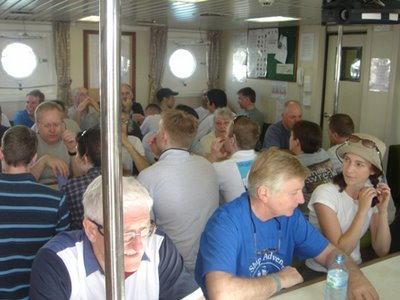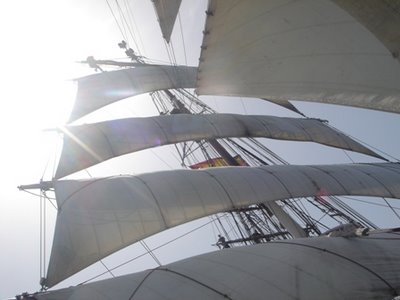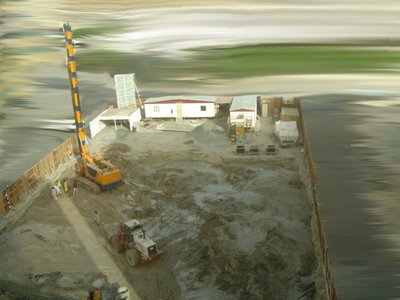However, that aside, I arrived at Palma airport and as expected, failed to recognise anyone else who would be on the voyage. Taxi seemed the most logical way to get to the vessel, but my Spanish is limited to "Dos cervesas por favor", which is not useful when trying to explain my destination to a driver who knew hno hEngleesh. I was first to arrive on board, having identified a pair of square-rigged masts among the veritable forest of yachts that adorn Palma's sea front.
The Prince William is registered as a sail training vessel. She was built in Appledore in Devon in 2001, and includes all current maritime safety facilities including watertight doors, enough inflatable lifeboats for nearly one each, and a chart room with more navaids than a well-stocked chandlery. The rigging is to the eighteenth century design, when square rigging technology reached its zenith.
The permanent crew made the forty-seven voyage crew (me and my forty-six colleagues) welcome and introduced us to our watch leaders, volunteers who were also paying for the privilege of a week under wind-propelled canvas. Each watch got two cabins of eight very narrow bunks and the same number of even narrower lockers, we were issued with waterproofs and safety harnesses, and after a pep-talk the pre-voyage training started in earnest.
Everyone was assigned a bracing station. The big burly blokes got the heaving side and the lighter and more delicate flowers got the other side. Basically, a command from the captain to "Brace to port" meant that all the hard macho types formed up on the left side, and once the starboard braces were loosened, pulled the yard-arms around to port in a precision ballet of heavy engineering to the well-known lyrics: "Two-Six. Heeeeave!" This was repeated all week every time the brig or the wind changed direction.
And now the bit warranting the safety harnesses. One of the features of sailing vessels is the need to climb up regularly to the yards. Sails are normally bundled up on top of the yards and held in place by bits of string called gaskets. To put the sails 'in gear', the crew has to climb up and out along wobbly foot-ropes and untie the gaskets. This is all fine and dandy except for obese, middle-aged vertigo sufferers who found it a bit of a struggle. The lower yards are relatively OK, but up past the Course, Lower Topsail and Upper Topsail towards the Top Gallant and Royal got progressively more hair-raising. I have seldom been more terrified.

OUT ON A LIMB: Some fellow mariners on the lower topsail yard
'Handing the sail' is the reverse procedure. It's trickier because this involves bundling up a 30 square metre sheet of billowing canvas and tying it to the yard. I shan't complain again about folding bedsheets. The bottom (or outer) corners need special treatment, and the term 'not having a clew' refers specifically to my inability to reach far enough down to grab the metal ring. I can't help not being built like some mutant gibbon. Much profanity later I finally grabbed it with my spare set of white knuckles. Incidentally, with a breeze from behind the gaskets don't hang vertically, which makes them even more difficult to grab. Nevertheless, there's a good view from the top. It mostly comprises a very small sailing vessel about 45 metres away.

GOOD VIEW: But it's a long way down
For lovers of comfort food, the galley was excellent. Three full meals a day were provided, plus unlimited biscuits, tea, coffee and orange squash. Second breakfast was available daily, as were second lunch and second dinner. The dimensions of the crew mess meant that daily workers were assigned from each watch to serve food and recover the empties.

CRUISE MESS: Crew's mess, actually
The day workers also got mess-cleaning duties, washing up and other kitchen menial tasks. Other watch members got to be the bosun's daily help. My own turn as 'bosun's bitch' was curtailed by a day's shore leave in Soller on Mallorca. Everyone got to do 'happy hour', a general daily clean of the accommodation, heads, showers and decks to the accompaniment of Dire Straits over the PA system.
I want my -
I want my voice to break...
The Prince William has a wind-seeking bowsprit. This means that whichever way we turned, the wind turned with us. It's impossible to sail a square-rigger closer to the wind than about 70 degrees without use of the Iron Topsail, a big, green, noisy, smelly device hidden in the hold. The wind was favourable upon leaving Fornells on Menorca and we were able to leave harbour under canvas. The wind made up for its earlier blunder on the morning we left Soller. We hit a Force 7 and found ourselves making seven knots with only one sail set.

UNDER SAIL: Windjammin'
There were dolphins too, but alas no photos because everyone was busy 2-6-heaving. A certain amount of other heaving also unfortunately occurred. Luckily, the Grumpy Goat has a cast-iron constitution where matters maritime are concerned. That aside, the weather was glorious all week. No rain at all, and the waterproofs were entirely unnecessary. It must be said that persistent rain might have made enjoyment of the week very short indeed.
Last week I hadn't the first idea how square-riggers worked. Now I have a basic knowledge. I even learned a few things. Did you know, for example, that the traditional sailor's pierced ear may be related to an acupuncture point that (allegedly) improves night vision? And that strictly a 'ship' is a vessel with square rigging and three or more masts? The only extant ships are the Cutty Sark and Victory.

THE END: Sunset


